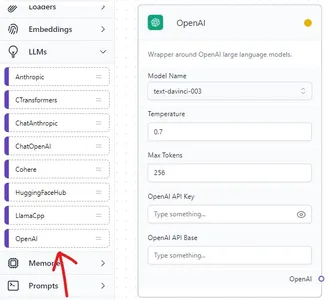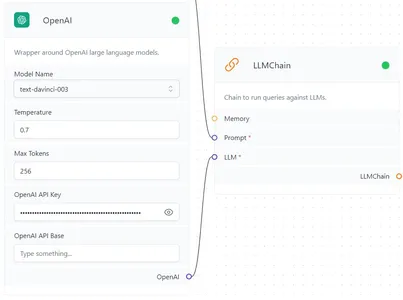UI for LangChain to Develop Purposes with LLMs

[ad_1]
Introduction
Massive Language Fashions have taken the world by storm. With the entry of ChatGPT, GPT3, Bard, and different Massive Language Fashions, builders are continuously working with these fashions to create new product options. With every new day comes a brand new Massive Language Mannequin or new variations of present LLMs. Maintaining with these new variations or new Fashions may be problematic as a result of one has to undergo the documentation of every such Massive Language Mannequin. LangChain, a library that wraps round all of the completely different LLMs, makes issues simpler. Furthermore, LangFlow, a UI primarily based on LangChain, was launched to immediately work with and create purposes, making issues significantly better.
Studying Goals
- To grasp LangFlow UI
- To put in and work with LangFlow
- To be taught the interior workings of LangFlow
- Utilizing LangFlow to create purposes
- Share the purposes made by means of LangFlow
This text was printed as part of the Data Science Blogathon.
What’s LangFlow and Why LangFlow?
LangFlow is a Graphical UI that’s primarily based on the Python Bundle LangChain designed with react-flow. LangChain is Python Bundle that works to create purposes with Massive Language Fashions. It constitutes of various Elements like Brokers, LLMs, Chains, Reminiscence, and Prompts. Builders chain these blocks collectively to create purposes. LangChain incorporates wrappers for nearly all the favored Massive Language Fashions. Now to make use of LangChain, one should write the code to create purposes. Writing code typically may be time-consuming and even error-prone.
That is the place LangFlow suits in. It’s a graphical UI primarily based on LangChain. It incorporates all of the Elements that are available LangChain. LangFlow offers drag and drop characteristic, the place you possibly can drag Elements onto the display and begin constructing purposes from Massive Language Fashions. It even incorporates wealthy examples for everybody to start out with. On this article, we’ll undergo this UI and see the best way to construct purposes with it.
Let’s Begin with Langflow
Now, we’ve got checked out what’s LangFlow, and the way it suits in, let’s dive into it to get a greater understanding of its performance. LangFlow UI is obtainable for each Javascript and Python. You’ll be able to take one out of it and begin working with it. For the Python model, one must have Python of their system, and the LangChain library.
If you wish to work with LangFlow, you want the under Packages
pip set up langchain
pip set up langflow
The above will set up the Langflow Bundle and the LangChain Bundle. Now to start out up the UI, use the next command
python -m langflow
(or)
langflowNow the LangFlow UI is up and working. It’s working on the native host on Port Quantity 7860. This fashion you possibly can set up and begin working with LangFlow.
The makers of LangFlow i.e. the LogSpace AI have immediately deployed LangFlow on HuggingFace Web site. You’ll be able to click on here to go to the HuggingFace web site or search Google. It would look one thing just like the one under, then click on on New Mission.

Once you click on on Create New Mission, the LangFlow UI will seem.

Right here the white area is the place we’ll create the purposes by dragging the Elements. And the comps are current on the left aspect (Brokers, Chains, Loaders, and so on). So once you click on on Comps, you might be offered with differing types, from which you’ll be deciding on one and drag it to the white area. Within the white area, you’ll then mix completely different Comps to make up all the utility.
Understanding the LangFlow UI
On this part, we’ll briefly perceive the UI of LangFlow, the Parts current it, and the way the UI works, to get a greater understanding of the best way to construct Massive Language Purposes rapidly with LangFlow

Within the above pic, we see the highest proper part of the LangFlow UI. The icons’ meanings may be comprehensible. The second icon represents the Export possibility. So once we construct an utility by means of LangFlow, and now we need to obtain it to our native machine. Then we will accomplish that by changing our utility config to a JSON file. Clicking on the Export possibility will allow you to obtain the JSON file that incorporates the data of your utility. Now in case your buddy desires to construct the identical utility, he can simply click on on the primary possibility which is Import, after which cross your JSON file to it.
The third possibility converts your utility to a Python Code, which you’ll be able to then work with immediately in your native system, as a substitute of going to the LangFlow web site each time you need to use that utility.

LangChain has wrappers for a lot of Massive Language Fashions. Every Massive Language Mannequin has its API to work with. So when attempt to work with an LLM within the LangFlow, it offers us the choice so as to add the API Key which may be seen above. Together with that, we even have the choice to pick out the kind of Massive Language Mannequin we need to work with.
Constructing a Easy Chat Utility with LangFlow
On this part, we will likely be making a easy chatbot utility working with the LangFlow UI. This utility includes working with OpenAI Massive Language Fashions, so an Open API Key needs to be current to work with this utility. The appliance we’ll create is a chatbot that can reply to consumer questions funnily.
So the appliance we will likely be creating can have 3 parts, the Massive Language Mannequin, the Immediate Template, and the LLM Chain that connects them. Let’s first begin by dragging LangChain’s OpenAI wrapper onto the dotted part within the UI.

OpenAI Massive Language Mannequin Wrapper
The Open AI Massive Language Mannequin wrapper may be discovered within the LLM part of LangFlow. We are able to drag it to the white part. Right here we now choose the kind of mannequin we need to work with. For now, I’ll set it to Davinci mode. And the temperature, i.e. how inventive the mannequin needs to be, is ready to 0.7 and max tokens to 256. Within the discipline Open API Key, we have to present the Open API Key, and the sector under that may be left clean.

From the pic, we see that we’ve got dragged the Immediate Template to the white part. Right here the appliance we’re growing is an easy bot that replies funnily, so we’ve got to put in writing the Immediate template accordingly.
Immediate Template
You're an AI bot that responds to every question given by the Human in a humorous means.
Human: {question}
AI:
Now come to the final aspect, which is the Chain aspect. The LLM Chain is the one combines that’s chains our OpenAI Massive Language Mannequin and the Immediate Template collectively. We are able to see that the LLMChain may be discovered within the Chains part to the left aspect of the UI. Lastly, it’s time to chain all of the issues collectively.


Just like the pics above, join the Immediate Template to the Immediate of the LLMChain and join the OpenAI finish to the LLM finish of LLMChain.
Now time to check our utility. For the appliance to run, click on on the Thunderbolt Icon current on the underside proper a part of the UI. If the OpenAI secret is legitimate, then on every of the Parts, on the highest, close to the weather identify, a inexperienced dot will likely be displayed (initially it’s yellow) then you’ll be seeing a Blue Chat Icon under the Thunderbolt Icon. Click on on the Blue Chat Icon.


After clicking on it, a chat window will open so that you can chat. Now you possibly can chat with the Massive Language Mannequin that we’ve got given within the UI. Let’s strive asking the bot “How are you?”, for this, the bot wants to present a response funnily.


We are able to see that the bot certainly has responded funnily by following our Immediate Template. Share with anybody by simply exporting it to the JSON. That is simply one of many pattern use circumstances of what we will obtain with LangFlow and LangChain.
Conclusion
LangFlow UI is constructed on high of Python’s LangChain Framework, a Bundle that’s extensively labored with to create purposes with Massive Language Fashions. We’ve seen the Elements within the UI, and have seen how one can construct fashions with the UI and share them with one other individual by exporting them to a JSON file. With this UI, the probabilities to create high-end purposes are countless.
Key Takeaways
- LangFlow offers a simple drag-and-drop characteristic to construct purposes with LLMs
- LangFlow UI is obtainable in each Python and JavaScript
- This UI permits customers to transform their utility to JSON information, thus making them straightforward to share
- LangFlow even comes with a Python bundle, which the consumer can set up and run the appliance in-built LangFlow by offering the trail to the JSON file
- LangFlow makes it simpler for non-developers to construct purposes with Massive Language Mannequin
Often Requested Questions
A. LangChain is a Python Bundle to construct purposes with Massive Language Fashions. It incorporates a set of elements chained collectively to create these purposes.
A. Whereas LangChain is a Framework offering instruments for growing purposes with Massive Language Fashions. LangFlow is a UI constructed on high of LangChain, to make the event course of smoother with a No Code Low Code idea.
A. Python and JavaScript programming languages assist LangFlow. One can work with it immediately by means of the HuggingFace web site.
The media proven on this article just isn’t owned by Analytics Vidhya and is used on the Creator’s discretion.
Associated
[ad_2]